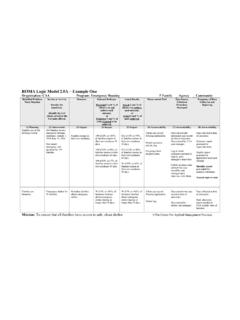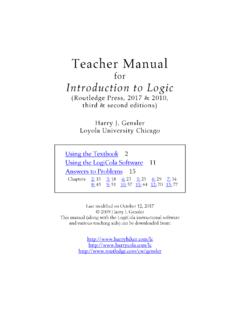Transcription of Evaluation Support guide 1.2 Developing a Logic …
1 Charity No SC036529 1 Company No SC284843 Evaluation can help you to work out what difference you are making through your services or activities. Evaluation Support guide helps you to clarify your aims, outcomes and activities. This is a practical guide that focuses on how you put together a basic Logic model to help you think about your aims, outcomes and activities. Voluntary and community projects can struggle to show the link between their activities and outcomes and the long term strategic outcomes set by government or funders.
2 Outcomes for individuals and communities take time and sometimes need multiple interventions. It can be a challenge too to know what and when to evaluate. One approach that can help us to get to grips with these challenges is Logic modelling. This guide comes out of work that we did with funding from NHS Health Scotland to help build understanding about Logic modelling. For that reason we focus on health throughout this guide . But the concepts are relevant for any subject area. A Logic model tells the story of your project or programme in a diagram and a few simple words.
3 It shows a causal connection between the need you have identified, what you do and how this makes a difference for individuals and communities. Here are two simple examples: Curing a headache Jones Family get active plan Evaluation Support guide Developing a Logic model Charity No SC036529 2 Company No SC284843 Logic models can help you to: 1. Think about why your project or programme exists, why you do what you do and why you think that makes a difference.
4 They can help you explore and develop a shared understanding about these things. 2. Plan a new project. In fact Logic modelling is really a fancy word for planning. It can help you to think about the need and what you will do to address that need. 3. Communicate your thinking to people who Support or benefit from your work. 4. Develop your Evaluation plan. A Logic model can help you to identify what you expect to happen, and when. It can therefore provide a pathway or road map for measuring progress. 5. Identify project or programme risks and how you might manage them.
5 Types of Logic models There are many types of Logic model . People use different versions for different purposes. In this guide we concentrate on the two models that are most frequently used for Evaluation . The Weaver s Triangle The simplest version of the Logic model is The Weaver s Triangle. This planning and Evaluation tool is adapted from the Charities Evaluation Services Planning Triangle developed by Jayne Weaver. You can use this model to help you to clarify your aims and activities (see Support guide : Clarifying your aims, outcomes and activities).
6 Aim Improve community health Outcomes 1. people have more access to Support & advice 2. people feel less isolated 3. people can cope better 4. people make healthier choices Activities a. Complementary therapy: 1 b. Cr che: 1 c. One to one work: 1, 2 & 3 d. Group activities: all d. Information services: 1 & 3 e. Policy work: 1 Example: Glasburgh Health Project Charity No SC036529 3 Company No SC284843 Community projects with a limited number of activities and outcomes will probably find the Weaver s Triangle is enough to help them clarify their Logic and identify what to evaluate.
7 You can make the triangle more sophisticated by drawing arrows or making numbered connections between the activities and outcomes as we have done in the example above. You can also try to sequence your outcomes. However it can become a bit untidy and may limit your ability to question some of the underlying Logic assumptions. The Weavers Triangle is not always good at showing visually the connection between different parts of the model or identifying at what point things happen. So, for more complex organisations or programmes, you might want to use the next model .
8 The Wisconsin model One of the most common formats for Logic modelling comes from the University of Wisconsin s United Way programme which is itself drawn from work on log frames. There are references at the end of this guide . Here are the components of the Logic model framework: There is an example on the next page (not including assumptions and external factors): Charity No SC036529 4 Company No SC284843 Glasburgh Health Project Situation/ needInputs Outputs activitiesparticipantsShort term outcomesMedium term outcomesLonger term outcomesArea of multiple deprivation, high morbidity rates, high numbers on incapacity benefitsStaffVolunteers Money Community health centreComplementary therapyCreche 1.
9 1 workGroup activitiesInformation servicesPolicy workParents with small childrenPeople suffering stress or mental health issuespost natal depression and domestic violenceWalkers groupFood and nutrition groupSchool groupsAll people: self selectLocal agencies delivering services affecting healthPeople make healthier choicesImproved knowledge and understanding of factors affecting healthImproved skills to bring about healthImproved local policy affecting health and well beingPeople have more access to Support and advicePeople are better able to copePeople feel less isolated People have an increased sense of control over their livesTemporary pain relief.
10 Boost in well beingIncreased connections between groups and individualsLocal people are healthier This model allows Glasburgh Health Project to show the links between their activities and their immediate planned outcomes and the sequence of outcomes that lead to the big outcomes of the Health Board (local people are healthier). It is therefore a richer picture than a Weaver s Triangle. We can also start to see what Glasburgh needs to evaluate and when. They can see which outcomes they need to measure shortly after the activities begin and which will take longer to happen.








